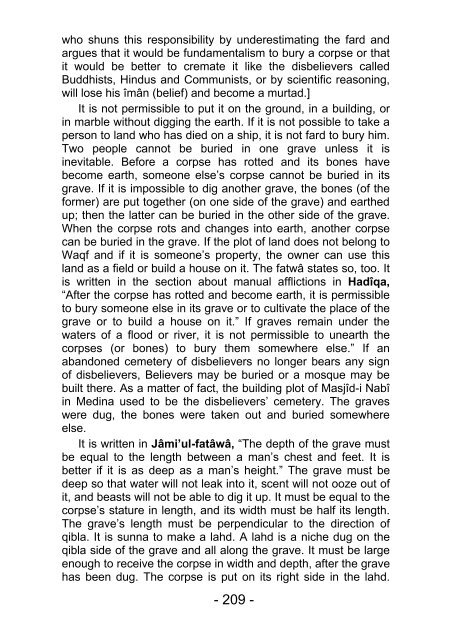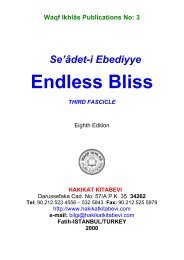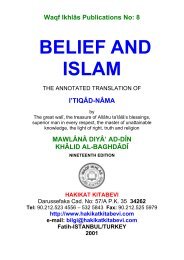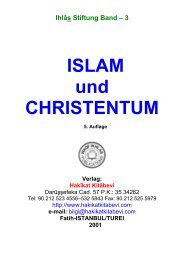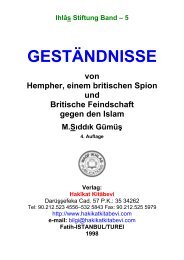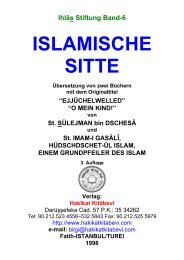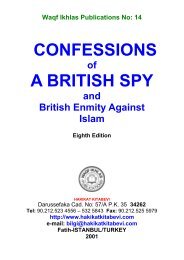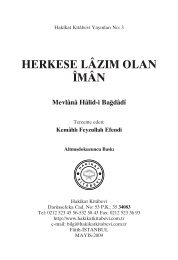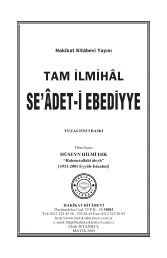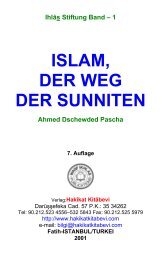5-Endless Bliss Fifth Fascicle - Hakikat Kitabevi
5-Endless Bliss Fifth Fascicle - Hakikat Kitabevi
5-Endless Bliss Fifth Fascicle - Hakikat Kitabevi
Create successful ePaper yourself
Turn your PDF publications into a flip-book with our unique Google optimized e-Paper software.
who shuns this responsibility by underestimating the fard and<br />
argues that it would be fundamentalism to bury a corpse or that<br />
it would be better to cremate it like the disbelievers called<br />
Buddhists, Hindus and Communists, or by scientific reasoning,<br />
will lose his îmân (belief) and become a murtad.]<br />
It is not permissible to put it on the ground, in a building, or<br />
in marble without digging the earth. If it is not possible to take a<br />
person to land who has died on a ship, it is not fard to bury him.<br />
Two people cannot be buried in one grave unless it is<br />
inevitable. Before a corpse has rotted and its bones have<br />
become earth, someone else’s corpse cannot be buried in its<br />
grave. If it is impossible to dig another grave, the bones (of the<br />
former) are put together (on one side of the grave) and earthed<br />
up; then the latter can be buried in the other side of the grave.<br />
When the corpse rots and changes into earth, another corpse<br />
can be buried in the grave. If the plot of land does not belong to<br />
Waqf and if it is someone’s property, the owner can use this<br />
land as a field or build a house on it. The fatwâ states so, too. It<br />
is written in the section about manual afflictions in Hadîqa,<br />
“After the corpse has rotted and become earth, it is permissible<br />
to bury someone else in its grave or to cultivate the place of the<br />
grave or to build a house on it.” If graves remain under the<br />
waters of a flood or river, it is not permissible to unearth the<br />
corpses (or bones) to bury them somewhere else.” If an<br />
abandoned cemetery of disbelievers no longer bears any sign<br />
of disbelievers, Believers may be buried or a mosque may be<br />
built there. As a matter of fact, the building plot of Masjîd-i Nabî<br />
in Medina used to be the disbelievers’ cemetery. The graves<br />
were dug, the bones were taken out and buried somewhere<br />
else.<br />
It is written in Jâmi’ul-fatâwâ, “The depth of the grave must<br />
be equal to the length between a man’s chest and feet. It is<br />
better if it is as deep as a man’s height.” The grave must be<br />
deep so that water will not leak into it, scent will not ooze out of<br />
it, and beasts will not be able to dig it up. It must be equal to the<br />
corpse’s stature in length, and its width must be half its length.<br />
The grave’s length must be perpendicular to the direction of<br />
qibla. It is sunna to make a lahd. A lahd is a niche dug on the<br />
qibla side of the grave and all along the grave. It must be large<br />
enough to receive the corpse in width and depth, after the grave<br />
has been dug. The corpse is put on its right side in the lahd.<br />
- 209 -


